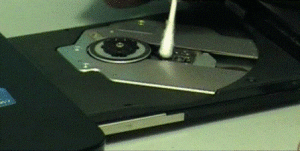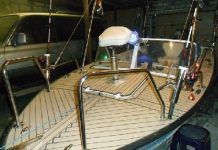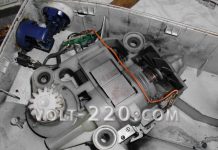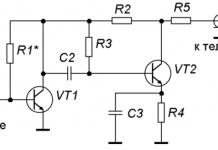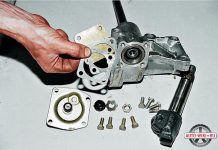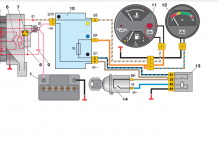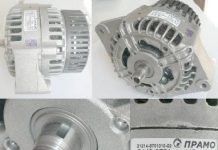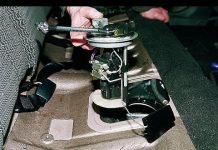In detail: do-it-yourself cd drive repair from a real master for the site my.housecope.com.
Laser drives are widely used in electronics. Any DVD-player, CD / MP3-tape recorder, music center are equipped with a laser drive.
In most cases, such devices are repaired precisely because of the breakdown of laser drives.
Malfunctions caused by a breakdown of a laser drive are quite similar, and boil down to one thing - either the laser disc cannot be read, or the playback of music (CD / MP3) or video (DVD) fails.
It should be noted that the service life of a laser diode, which is included in any disk apparatus, is on average 3-5 years. It would be naive to think that a DVD player will last 10 years or more! Take a look at your DVD player manual ...
In general, the first thing to ask when a disk apparatus is brought to you for repair is how old the apparatus has been and how intensively it has been used. If the answer is 3 or more years, then the probability that the optical unit is faulty increases dramatically. How often the device was used is also important, because a laser drive is an electronic-mechanical device. The number of miniature motors in one laser drive is unlikely to be less than 2-3.
The first of the three - spindle drive. He is responsible for spinning the laser disc. A very large number of malfunctions are associated with it. Here's an example.
Second - optical block drive. This drive is responsible for positioning the laser head along the disc. It rarely fails.
Third - loading / unloading drive (LOAD). Unloading and loading the disk into the drive. Malfunctions of this engine are quite rare and usually easy to repair.
| Video (click to play). |
In practice, such a malfunction is common. Mostly in CD / MP3 car radios.
The sound often disappears during playback. It appears abruptly and also disappears. Stuttering is present.
Have DVD players the malfunction manifests itself as follows.
The disc is read for a very long time, after which the display shows (ERROR or NO DISK). The disk may freeze up accidentally. Reinserting the disc solves the problem and the recorded disc plays back normally.
The reason for this "incomprehensible" behavior is not associated with a malfunction of the optical laser unit, but with a malfunction of the spindle drive.
The fact is that the spindle motor must spin up at a certain speed. The speed is adjusted by a feedback system. So don't think that the disc is spinning by itself. Applied 3 volts to the engine and that's it! Not! The speed of rotation of the disk is regulated by a complex adjustment system. If the spindle motor is defective, then even the correction system does not handle well and malfunctions occur. The engine does not give out the required rpm, it “fails”.
Therefore, if the malfunction described below appears, do not rush to replace the optical laser unit!
Replacing the spindle drive is cheaper than buying an optical laser unit. You can temporarily replace the drive with a motor from another device or find a suitable one in the store.
A very common problem is with CD / MP3 recorders with vertical disc installation.
The disc spins up, but the disc does not load. Writes ERROR or NO DISK.
The optical laser unit is afraid of dust and dirt... A thin finely dispersed dust deposit on the upper lens is enough for the disc to stop being read. Vertical disc recorders are more vulnerable to dust, the disc is loaded from above and the amount of dust that gets in increases.
In this case, disc car radios are more protected, they have a slot loading disc.
Fine dust deposits can be removed from the surface of the lens of the laser unit with an ordinary cotton swab or just a piece of cotton wool. Moisten cotton wool with cleaning agents no need, you can ruin the lens! Using a cotton swab 3-4 times on the surface of the lens in a circular motion. Making sure that there are no residues of coarse dust on the lens and that's it!
Do not press on the lens, it is attached to spring cables! They supply power to the focusing electromagnet. They are quite sturdy, but with excessive force they can be damaged.
It is not uncommon that after such a simple cleaning, the operation of the device is completely restored.
The main difficulty in this operation is to properly disassemble the device and get to the laser head. This is most difficult for music centers with a 3-disc loading unit or changer (when the discs are placed in a box - like plates in a dryer), as well as for car CD / MP3 players and DVD players with a slot loading disc.
Therefore, on the pages of the site, I posted information on disassembling all kinds of CD drives:
These techniques will help if you need to disassemble a CD drive, but there is no experience in this matter.
Sometimes cleaning the lens does not help. The reason is that there is a prism inside the optical unit, dust will settle on it over time. It makes no sense to disassemble the optical unit. Better to replace the entire block.
When repairing electronics with faults that clearly indicate a defect in the laser drive, you can use the following techniques:
Check the mechanical part of the laser drive for jamming of gears, carriages, serviceability of flexible connecting cables. It is better to “ring” flexible cables with a multimeter, and it is better to check with a replacement. Very often the loop “rings” by the multimeter as if it is working, but since it bends during operation, the bad contact again makes itself felt.
In DVD players, the “weakest” ribbon is the one that connects the laser head to the main board. Replacing it often fixes a problem with a “freeze” disk, bad or long loading of the disk, and playback failures.
Check if there is a laser light. After inserting the disc, the red laser turns on (only for DVD) for a few seconds. At this moment, it is necessary to check the presence of a glow while looking from the side. Remember! Laser is harmful for health! Direct eye contact with the laser beam can result in loss of vision. Be careful!
Clean the lens of the optical unit. How to do this has already been described.
Visually trace the loading of the disc, its spinning. Replace the spindle drive using the substitution method.
If possible, replace, at least temporarily, for inspection, the laser optical unit. Here's how to quickly replace laser in DVD.
In addition to the laser, there may be other causes of the malfunction. I have already talked about the main malfunctions of DVD-players.
The topic of repairing disk devices is quite extensive, here are just a few recommendations and tips. For a deeper understanding of the operation of laser disc players, it will not be superfluous to familiarize yourself with the general principles of operation of such devices. I think the book “CD-players. Circuitry "Avramenko YF, will be very useful for understanding the operation of disk devices.
Disk drive repair. Prevention and Treatment.
Mechanical failures are the main causes of drive failures. They make up about 75-80% of the total number of malfunctions and repairs associated with it. Moreover, most often the reasons for the failure of DVD drives (any, not only computer ones) are contamination of the moving parts of the disc transport mechanism and dust accumulated on the optics. Repairing a drive will almost guarantee it will be adequate to the cost of a new one, so we carefully read and weigh whether the skin is worth the candle.
Repairing a floppy drive is not a trivial task.
The presence of dust and dirt on the moving parts of the mechanism, especially on the edges of the movable carriage sled, makes it impossible to lock the drive mechanism holding the disc, as a result of which the device does not fix the disc and constantly throws it out. If, on the contrary, the drive ejects the tray and immediately picks it up, then, most likely, the cause of the defect is the failure of the tray position sensor. The fact that the tray is thrown out is determined by the drive with the help of a contact sensor, which should be found, try to correct its position, repair or replace. Repairing the drive itself is not necessary here; from time to time, just make sure that dirt does not accumulate in the places where the slide moves.
The optical drive system often fails due to dust accumulated on the focal lens or prism. If blowing out the device does not help, you can try dusting the lens with a soft flannel or a brush, as shown.
Remember that under no circumstances should you use alcohol or solvents for cleaning!
The situation is more complicated with the prism that stands behind the lens - it is extremely difficult to get to it. Moreover, the head, as a rule, is not collapsible, but even if it is disassembled, then you can knock down its settings. Therefore, for most drives, a dirty lens means it is completely unusable. Sometimes the optical system fails even due to an ordinary hair caught on the prism - in this case, again, you can try to blow through the system with a powerful stream of air. Otherwise, the repair of the drive (its cost) will be unreasonably high.
However, most drives operating under normal conditions do not survive to the stage where dust can cause failures. Most often, the plastic of the lens simply becomes cloudy from time to time and / or from overheating of the drive in the system unit. Disk drive repair consists of an expensive replacement of the laser read head. However, such a malfunction accounts for no more than 10% of cases. Here you can, of course, advise to increase the intensity of the laser glow. For this, the variable resistor installed on the carriage with the laser is regulated. Turn the slider of this variable resistor clockwise by 20-30 °, after which the fact of rotation of the drive motor is checked when the disk is installed. If the disk does not begin to rotate, then turn the variable resistor slider another 20-30 °, and continue this way until the motor starts (it should start and for some time - about 10-20 seconds - rotate at a constant speed) ...
The need to rotate a variable resistor that regulates the intensity of the laser light is due to the fact that over time the power of the laser light flux decreases (aging of the elements, clouding of the lens, etc.), however, after such an adjustment, the optical system usually does not last long anyway. Such allegedly repairing a drive is no longer practiced.
You will hardly be able to eliminate other malfunctions of the optoelectronic information reading system on your own. Despite its small size, the optical system of the DVD drive is a very sophisticated and precise optical device, including servo control systems for the rotation of the disc, positioning of the laser reader, autofocus, radial tracking, and a readout and laser diode control system. Repairing the drive is not worth it in this case.
Typical signs of a malfunction are either the lack of rotation of the disk, or, conversely, its constant acceleration to the maximum rotation speed. When you try to remove a disc from a faulty drive using the controls, the carriage opens with the disc rotating on it.
In the operation of a working system, the following phases should be clearly traced:
• start and smooth acceleration of the disk;
• steady state of rotation;
• interval of braking to a complete stop;
• removal of the disk by the carriage tray from the engine spindle and its removal out of the drive.
You can check that the optical system of the drive is working properly by opening the case of the device and observing its operation. You can make sure that the disc spins up after installation by connecting only the power cord to the drive (the data cable is not connected in this case). If the disk does not rotate after installation, then check whether the laser is shining when the carriage is installed in the working position, but without the disk. Sometimes the glow of the laser is not visible in daylight, so the room needs to be darkened. Observation of the laser lens should be carried out from different angles.
In modern optical devices, the presence of a disc is controlled by the laser itself. If the photosensor installed in the laser carriage receives a reflected signal from the disk, then the electronic circuit perceives this signal as “presence of the disk” and only after that generates a command to turn on the main engine of rotation. Therefore, if the intensity of the laser light is insufficient, then the disc will not spin up and the repair of the drive will become inevitable.
The servo system for positioning the information readout head provides a smooth approach of the head to the specified recording track with an error not exceeding half the track width in the search modes for the required piece of information and normal playback. The movement of the read head, and with it the laser beam along the disk field, is carried out by the head motor. Engine operation is controlled by forward and reverse motion signals from the control processor, as well as signals from the radial error processor. The characteristic signs of a malfunction are both the erratic movement of the head along the guides and its immobility.
You can visually check the correctness of the focusing system. At the start of the disc, the control processor generates correction signals that provide multiple (two to three attempts) vertical movement of the focus lens, which is necessary to accurately focus the beam on the disc track. When focus is detected, a signal is generated to enable reading of information. If after two or three attempts this signal does not appear, then the control processor shuts down all systems and the disk stops. Thus, the operability of the focusing system can be judged both by the characteristic movements of the focal lens at the moment of starting the disk, and by the signal to start the disk acceleration mode upon successful focusing of the laser beam.Other parameters of the correct operation of the optical system are not visually determined.
Optical drives also have many mechanical components that require lubrication of the rubbing parts. The lack of lubrication leads to the fact that the drive hardly pushes the carriage with the disk, and the carriage lock can generally jam, and then the use of the drive will become completely impossible. The lubricant must be applied carefully, after having completely disassembled the device (the places where it is required, as a rule, are clearly visible). Before lubrication, it will be useful to clean the lubrication points of dust and dirt. The fact is that if you miss the moment when you need to apply lubricant, then the difficulty of sliding will lead to mechanical damage to the parts of the transport mechanism or to a violation of its adjustments, which, in turn, will entail either the stop of the carriage mechanism in an intermediate position, or slipping of the disc during rotation time.
A similar situation can arise due to grease on the friction surfaces of the disc holder due to the frequent use of dirty DVD discs, which ultimately leads to unreliable operation of the drive, even to a complete stop.
Contamination of the disc drive seat and poor clamping of the disc to the seat can be eliminated by cleaning the disc seat with any cloth moistened with alcohol.
You can check if there is enough force to hold the disc against the seat when trying to play a regular disc. If there are no errors or failures during disc playback, and the disc with computer data is still unstable to read, you can take additional measures - bend the springs or increase the weight to increase the pressure on the disc from above.
Other mechanical failures include jamming of the disc on the transport carriage (in this case, the disc does not spin at all). Sometimes this happens because the seat of the disc spontaneously descends along the motor shaft and the disc touches the elements of the transport carriage. To eliminate this defect, the seat is moved upward along the shaft and its height is selected "by poking" so that the disc rotates without touching the structural elements, and also so that the drive ensures stable reading of all discs. After that, the position of the disc seat is carefully fixed on the shaft.
However, the listed mechanical faults relate mainly to simple mechanisms of relatively cheap drives. Expensive models, as a rule, have complex mechanisms, for which the main type of mechanical failure is fatal breakdown of the mechanism parts. Most often this happens due to the fact that the user, instead of using the control buttons, pushes the carriage with the disk inside the drive by hand. The consequences of such actions can be the most unpleasant. If a dirty and running mechanism is enough to clean, wipe, and lubricate it to perform its functions properly again, rushing and applying excessive force to the disc tray can cause breakdowns that will cause expensive and time-consuming drive repairs.
Finally, electronic component malfunctions are possible. However, their share is unlikely to exceed even a small fraction of all breakdowns. Unfortunately, modern optical drives are very complex electronic systems, and a faulty microcircuit does not differ in appearance from a working one. Accordingly, repairing a drive at home without preparation is impossible.
Now drives may cost less than a network card or video card, but this does not mean that they are just as simple. The optical drive has a rather complex design and, in addition to the mechanical part, contains at least two microcontrollers, a signal processor (DSP), a secondary voltage source, circuits for controlling mechanics, etc. Moreover, most of the microcircuits used in modern drives are specialized, and therefore, repairing a drive in its electronic part is hardly advisable.
Note that in an optical drive it is quite difficult to diagnose an electronics failure even with a sufficient degree of reliability. Indeed, depending on the error correction strategy chosen by the manufacturer for a particular model and, accordingly, on the complexity of the processor and the device as a whole, in practice this or that drive can work with different disks in different ways. This, by the way, explains a common situation when your disk is easily read on a colleague's machine, but your own PC does not even see it. In cheap models, the correction system can correct only one or two minor errors in a frame of information, and a complex expensive system can restore even serious and extended destruction of information, and it does this in several stages according to a complex algorithm. So the repair of the drive in this case will not work due to the absence of a malfunction as such.
Each manufacturer uses its own chipset or completes it with products from different manufacturers, and, of course, does not attach a description. Due to the fact that for each specific device it is necessary to search for specifications for almost every microcircuit separately, often even the specialists of service centers cannot always restore the operability of your device. If only because the repair of the drive will not be economically justified.
In short, if, after cleaning, checking all the wires and connections, as well as system settings, your DVD drive does not work, and the warranty for it has already expired, you may end up with a situation where you just have to throw out the old one and buy a new one.
It's no secret that our stores are literally filled with cheap Chinese electronic products. All kinds of models of TVs, telephones, household appliances, DVD players pleasantly delight us with their price. Also, work has been added to the masters (for which many thanks to our Chinese manufacturers) who maintain and repair this equipment.
In this article I want to draw your attention to DVD players, since they are cheap, and repairs can cost an amount that slightly exceeds the cost of the device itself. Many of my clients, having learned how much it will cost them repair chinese dvd, simply throw their devices. The fact is that parts for such devices are quite expensive and if you add the cost of the repair itself, then it will be cheaper to buy a new one of the same type than to bring the old one to life.
This article is intended to help citizens who wish it, not to spend money on paying for the work of the master, but to try do it yourself DVD repair.
The reasons for such ailments of the player are also, for the most part, the same and are reduced, in turn, to the failure of the following elements:
The most common failure in DVD players is laser head... The malfunction may manifest itself in not reading discs, reading discs only of a certain format, freezing. Such a malfunction occurs, mainly due to low-quality disks, which "crumble" and contaminate the reader. Sometimes this problem can be eliminated simply by cleaning the head from dust and dirt. But, in most cases, it is necessary to replace this component with the same or an analogue.
Such a defect is eliminated by replacing the motor. When replacing, you need to install the engine together with the nozzle (they are sold that way). The distance between the motor and the nozzle must be certain, otherwise the head laser will not be able to focus the signal on the surface of the disc. It is quite problematic to set this distance manually.
Basically, in the production of DVD players, a processor such as MT1389 or similar is used. You can find out if the processor is buggy or not by heating it. If the processor is very hot, then you should check the elements that are on its power supply 1.8 V and 3.3 V.I want to note that in cheap Chinese DVD players there is no processor protection, as such, and power stabilizers are assembled on transistors (simplified diagram). In this regard, the normal stabilization of the processor supply voltage does not occur, and in case of an overload in the 220 V network, the processor itself or its power elements may fail.
If the power supply is correct, but the processor is still warming up, then it is faulty itself. Replacing the processor, in my opinion, is impractical, since its cost is quite high and additional equipment will be required to replace it.
The driver is the microcircuit that controls all the mechanics of the turntable: all motors, the focus coil of the laser lens, etc. The driver receives commands for control from the processor.
If it gets very hot and at the same time malfunctions of the mechanics appear (loading / unloading drive disk, not spinning, etc.), then, most likely, it was the driver that failed. In principle, it should warm up, but if its heating does not tolerate a finger, then you need to be on your guard. Also, the driver may warm up due to a malfunction of any engine, so before replacing it, you need to check all the motors.
To replace the driver, you will also need additional equipment, namely a soldering gun or hot air soldering station.
Please do not forget to share the article in social networks, maybe someone, thanks to you, will find useful information for themselves.
I just closed the player and the lid cracked near the hinges. Can you replace it?
You can, probably, if you find such a cover.
Please tell me I connect the microphone to the DVD, the sound disappears, two outputs - the result is the same - the sound disappears!
Hello! Tell me please! When ejecting a DVD disc from the BBK player, there is a crackling sound for a few seconds before the disc is ejected. Crackling sounds constantly when loading CDs. Also, when loading an empty tray, a crackling sound is also heard for several seconds. What could be the reason? Heard that it might be a bad contact or a malfunction of the disk loading sensor? Help with advice. Regards, Ivan.
Hello Ivan! The crackle appears due to the gear, the teeth are worn out.
Hello Victor, I would like to ask my portable dvd motor burned out to disk 3.0 found another unmarked unknown how many volts it has started to scream, but weakly and so it spins up, then when the author pours in and so the download is in progress, such a reason may not be suitable
Hi, Tolya! It is possible that this motor is defective or not suitable.
Maybe in volts, in power, in current.
Hello. DVD denon 3800 Disc is loading. the laser lights up, scrolls a few revolutions and that's it. stops lighting and spinning. 0 hours 0 minutes 0 seconds on the display.
Well ... maybe the laser is covered, maybe the engine ... you need to check
Hello, Victor, tell me, the screen does not light up in my DVD player, all the commands (which can be run in the dark) are working, there is sound. Maybe you can advise where to look (it seems to me that the backlight doesn't work, but I can't find it). Thank you
Do you have a portable DVD? Or is the display not lit?
DVD in a car with a monitor and the monitor does not light up
Perhaps the backlight ... I have not come across this.
We have such roads that everything falls off, on pits and bumps, and after another shaking, the screen stopped glowing.
I have such a Harman Kardon DVD22 device, can you tell me where to look and what to check, it says so, I have two of the above devices, one has been plowing for a long time and without problems, and since the sound from it suits I decided to buy another one of the same, and so , the one that was purchased not long ago behaves somehow strange - when you turn on the network, the indicator lights up in amber, and when you press on, even from the remote control, even from the button, it lights up in blue, so far everything is fine, only the display does not light up although you can hear that the disc is spinning , well, since this is how the device does not work as it should, I press the off button - the indicator remains onblue, that is, it does not react in any way, after three minutes of waiting, the indicator lights up in amber and here the most interesting thing is that you press the on indicator again blue, but the display is already on, everything works fine at least all day, drive it, after you turn it off and pass at least half an hour, then the whole cycle starts over again, this is not healthy garbage
Perhaps something with the firmware. Also see blown capacitors.
I did everything - at the autopsy 6 air ducts were swollen, after replacement everything worked fine.
Hello Victor, I stumbled upon your articles about repairs - I have a DVD with a karaoke function for two microphones, looking through your articles about repairs, I did not find any similar ones, the problem is that there is no circuit on the eltnberg 2440 to check the supply voltages, and the karaoke does not work, nothing comes from the microphones. Maybe you would advise ... ...
Yamaha DVDs creak, what is it and what to do? Is it possible to fix something yourself without contacting specialists?
The laser may be dusty. And if the creak is mechanical, carefully lubricate the gears and rotating elements.
Hello, dvd Denon 1940, when loading a disc for about 5 minutes, while the rpm is high, the roar of a spinning disc is heard from the player, which gradually decreases to nothing as the laser moves to the edge of the disc, on other available players this is not, what could be?
May need to lubricate the rotating elements
Hello! I have a DVD-VHS SAMSUNG DVD-V6800, he is 10 years old, but used very rarely. When I felt the urge to watch a movie, after 10 minutes the video cut off, the screen became black, and the disc continued to spin, hovering tightly. And after I took it out and inserted it again, I could not load: "the disc cannot be played." It's the same with other good discs.
Demolished for repair. The master said that it was necessary to change the laser head. Replaced. Brought home - the same nonsense one to one. The next day they carried it back, everything worked in the workshop, both with my disk and with the master's disk. In addition, the dust was blown out by the compressor, and the details on the board, as the master said, do not heat up. They brought it home - again the same thing, after 7 minutes everything hung. On the phone, the foreman said that he could not help if everything was working in the workshop. I don’t know anymore whether it makes sense to drag the player back to him if it works again.
Can you tell me what it might be? We have already paid 3,500 rubles for diagnostics and replacement of the head, but the player still does not work.
Perhaps the point is in the electrolytic capacitors in the power supply and your lower mains voltage.
Portable dvd player-TV subini s-6078dt.After a long period of non-use when turned on from an external power supply (good) or battery, the screen blinks and does not turn on, the red power indicator is on. Then he completely stopped showing signs of life, even the indicator was off. What could be? JD-DV708D-MB-SPD-01 board.
You must be logged in to post a comment.
This site uses Akismet to combat spam. Find out how your comment data is processed.
How to repair a CD-DVD drive yourself?
This is a short story with pictures on how you can revive a CD-DVD, and probably a Blu-Ray drive, without resorting to expensive professional help. There are several common reasons that can lead to complete or partial inoperability of the drive. The elimination of these causes is not a repair, but rather a maintenance of the CD-DVD-ROM and may well be performed by a user with some electronic skills. Learn more at my.housecope.com/wp-content/uploads/ext/1284
- Worn drive belt (belt).
- Increased friction in the loading mechanism.
- Dirty laser lens.
- Decrease in laser efficiency.
Removing any of these causes requires partial disassembly of the drive. The design of the drives may vary, so the accompanying pictures should not be taken absolutely.
For preventive maintenance, we need the following tools, materials and components. my.housecope.com/wp-content/uploads/ext/1284
- A paper clip.
- Phillips screwdriver.
- Medium brush.
- Calico (cotton fabric).
- Silicone grease SI-130.
- Belt.
- Cleaning cloth.
- Thin screwdriver.
- Tweezers.
Begin. Disconnect the cables from the drive and unscrew the mounting screws. We take out the drive from the case of the system unit.
Disassembling any CD-DVD drive begins with pulling out the tray. To slide out the tray, you first need to make a simple paper clip fixture.
Carefully, pushing the end of a paper clip into the technological hole on the front panel of the drive, we grope for the part of the mechanism that is responsible for blocking the tray. This detail is located strictly opposite the hole. Press on it and the tray slides out slightly. Now you can pull it out with your fingers.
We squeeze out the latches securing the front panel of the drive. First, squeeze one of the side latches.
Then, we squeeze out the latch located at the bottom of the drive, and the other side latch.
Pull out the front panel, unscrew the four Phillips head screws and remove the metal casing panels.
We squeeze the latches and separate the tray from the main mechanism.
Thoroughly clean the mechanism from dust and dirt with a brush. If the old grease is heavily contaminated, then we remove it with coarse calico and apply a new grease.
We replace the worn out belt with a new one. Then we wipe the belt and the inner surfaces of the pulleys with a cleaning cloth or coarse calico dipped in alcohol.
Wipe the laser lens with a cleaning cloth. Dust deposited on the upper surface of the lens may not be visible to the naked eye, but it is almost always present there.
If the drive is very old or it is known that too many discs have been written to it and there is a read or write problem, then you can try to increase the laser current. This rather delicate operation takes patience and can take quite a long time. Do not start this procedure if your drive simply does not read a few old discs or discs written on other people's drives. This can be caused by a lot of different reasons and the magnitude of the laser current is here in 38th place.
It is best to adjust the laser current when the actuator is in a semi-disassembled state.
To start the drive without the shroud and front panel, you will need to remove the front wall of the disc tray.
Somewhere on the carriage with the installed laser there is a small-sized potentiometer, the position of the slider of which determines the laser current. The location of this potentiometer depends on the design of the actuator.
Before turning this screw, be sure to sketch the position of the slot in order to have a reference point, and in general, so that you can return it to its original position if something happens.
Turning the screw 10-15 degrees, first in one direction and then in the other direction, each time we check the reading quality in some program, for example, Nero DiscSpeed.
It is only advisable to check on several types of media at once, for example, CD-R and CD-RW or DVD + R, DVD + RW, DVD-R, DVD-RW, etc. It is probably not necessary to check all types of supported media, but check at least the ones that you use all the time.
Multipurpose universal drives are rather compromise products and therefore they often read some types of discs better, and some worse. For example, by increasing the laser current, you can get perfect CD-R reading and make half of your CD-RWs unreadable.
The assembly does not present any difficulties, except for one moment. When inserting the tray into the loading mechanism, it is required to align the locking mechanism of the loading mechanism with the guide slot located at the bottom of the tray.
The slide is usually spring-loaded, so you need to fix the slide in the correct position using tweezers or another suitable tool before sliding the tray into the guides. In the photo, the position of the slider is fixed with an awl.
If, quite by accident, you have at your disposal a small set of belts of different diameters, then you just need to choose a suitable copy. If there is no such set, then you will have to buy a belt.
And although the era of video and audio tape recorders has passed, on all kinds of radio markets you can still buy rubber belts in stock.
When buying a belt, you need to pay attention to several of its parameters at once, such as: section, diameter, elasticity and quality of vulcanization of the rubber from which it is made.
The section of the belt can also be determined by eye, since the likelihood that you will be able to find a belt of a strictly corresponding section is small.
The diameter of the belt can be determined by attaching the old belt to the new one and make sure that the diameter of the new one is slightly smaller than the old one.
Elasticity can be measured using an impromptu stand, like the one in the picture.
I usually check the properties of a belt by touch without any dynamometers.
The quality of the vulcanization of rubber can be determined by the color and tactile sensations. The color of the "wrong" rubber is deep black and the surface is smooth and highly reflective. While the "right" rubber has a slightly grayish tint and a more matte finish.
Also, the quality of rubber vulcanization can be determined by the recovery time of the original size. For the test, you need to stretch the belt strongly with your fingers and very quickly drop it flat on a flat surface. The faster the belt takes its original size, the higher its quality. If you can notice by eye how the diameter of the belt changes, that is, it seems to shrink, then such a belt will not last long and it is better not to use it at all. However, it is not a fact that you will find a high quality belt at the bazaar, and even exactly the same as required. Therefore, for lack of the best, you can buy what you have, but adjusted for diameter, section and elasticity.
And so, all four of these parameters affect the properties of the belt. When choosing a belt, you need to take all of them into account. If the section of the belt is slightly smaller, then you need to choose the belt a little shorter and vice versa. If the quality of vulcanization is low, then you need to choose either a slightly larger section or a slightly smaller diameter.
If the belt is too tight, it can lead to seizure or premature wear of the disc loading mechanism. If the belt is too loose, it can cause it to slip relative to the engine pulley.
| Video (click to play). |
If there are several belts with similar properties in the bazaar, then it is better to buy several different ones at once in order to find the most suitable one at home. The price of a belt for a CD-DVD drive can range from $ 0.3 to $ 0.7.


